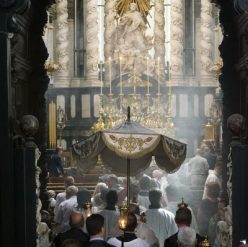The Congregation for Divine Worship and the Discipline of the Sacraments gave an answer to the following question on November 7th, 2000:
Does the Congregation for Divine Worship and the Discipline of the Sacraments in the Institutio Generalis Missalis Romani Nos. 314-315, or elsewhere, intend that a separate chapel for the reservation of the Most Blessed Sacrament within parish churches is to be preferred to a prominent and central location within the main body of the church, thus visible to the faithful during the celebration of the Mass?
The Latin answer is: Negative, et ad mentem. This means they will give the reason behind this, i.e. the mens.
Mens: Within the norms specified by the law, it pertains to the diocesan Bishop in his capacity as moderator of the Sacred Liturgy in the particular Church entrusted to him, to exercise judgment regarding the most appropriate place for the reservation of the Most Blessed Sacrament, bearing foremost in mind the purpose encouraging and enabling the faithful to visit and adore the Most Blessed Sacrament.
